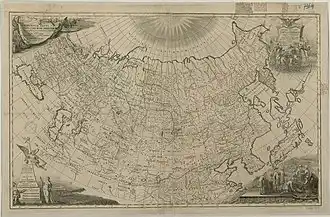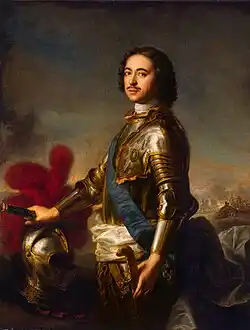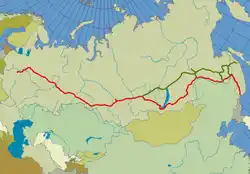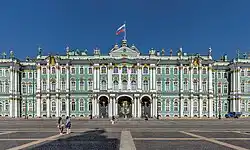
The Russian Empire was the political state that existed for nearly 200 years in Russia between the declaration of its creation by Tsar Peter the Great in 1721 down to the Russian Revolution and the inception of the Union of Soviet Socialist Republics (USSR) in 1917. This era witnessed enormous changes in the state and was formative in Russian history. As recently as the mid-sixteenth century, ‘Russia’ had constituted little more than the Duchy of Muscovy (Moscow) and lands south along the Volga River towards the Caspian Sea. When Peter proclaimed the birth of the Russian Empire it had only recently acquired access to the Baltic Sea, was not yet a Black Sea power, had not expanded into the Caucasus and Central Asia and had only a nominal claim to most of Russia east of the Urals, with little control there in practical terms. The era of the Russian Empire led to expansion in all these areas. Large migrations and population transfers occurred in tandem, with groups of European Russians colonizing Siberia and parts of Central Asia and minorities transplanted as part of imperial Russia’s policy of Russification.[1]
Research your ancestors on MyHeritage
Russian Empire chronology of eventsRussian Empire chronology of events
The manner in which Russia developed into the largest country in the world is quite remarkable. In the fifteenth century the Duchy of Muscovy was just one of several Russian principalities and city states along the upper course of the River Volga in what is now western Russia. These ultimately had their origins in the medieval activities of the Norse Rus’ back in the ninth, tenth and eleventh centuries. The various Mongol khanates that had survived from the Mongol Empire of Genghis Khan controlled much of what we now term Russia, while Siberia was a broadly stateless wilderness, thinly populated by hardy natives who could survive in its temperature extremes.[2]

That all began to change under Muscovite leaders like Ivan III, sometimes known as Ivan the Great. He conquered many of the other Russian statelets such as the Novgorod Republic and he and his successors began conquering the declining Mongol khanates southwards towards the Caspian Sea.[3] His grandson, Ivan the Terrible, proclaimed the birth of the Russian state out of Muscovy, while his successors undertook further expansions through the Northern Wars to acquire access to the Baltic Sea and to acquire territory in what are now Belarus, Ukraine and parts of western Russia from both the Cossacks of the Pontic-Caspian Steppe and from the Polish-Lithuanian Commonwealth. Ivan the Terrible’s reign had also seen the first Russian explorers strike out in a concerted way east of the Ural Mountains to begin colonizing Siberia, though this would prove to be a very slow process.[4]
The long reign of Tsar Peter the Great between 1682 and 1725 was a major turning point. Peter won access to the Baltic Sea from Sweden in the Great Northern War and began building the city of St Petersburg. He also began westernizing his country and proclaimed the birth of the Russian Empire in 1721.[5] The Russian Empire expanded greatly under Catherine the Great, who reigned from 1762 to 1796. She made Russia into a Black Sea power, expanded into the Caucasus, acquired a great amount of new territory in Eastern Europe through the Partitions of Poland and also expanded considerably into Central Asia around where countries like Kazakhstan are located today.[6]

All of these policies were furthered by her successors in the nineteenth century, though the period of most active expansion occurred in the eighteenth century. Instead the nineteenth and early twentieth centuries were more of a period of consolidation and development. As part of this a policy of Russification, whereby the Russian language, religions and culture was promoted in newly conquered lands, was developed. It saw colonies of Russians established in places like the Crimean Peninsula.[7] The development and opening of the Trans-Siberian Railway between 1891 and 1916 was undertaken in an effort to further open up the vast expanse of the country to new settlement of the kind which the American West and the Canadian Prairies had experienced in the second half of the nineteenth century. However, before that plan could come to any kind of fruition, the First World War broke out in Europe in 1914, ultimately leading to the Russian Revolution of 1917, the collapse of the Russian Empire and the birth of the USSR.[8]
Extent of migration during the Russian EmpireExtent of migration during the Russian Empire

There was extensive and varied migration across the vast lands that constituted the Russian Empire over a near two-centuries long period. This took place in different places, at different times and involved different degrees of population transfers, colonization and Russification. Moreover, given that for much of this period Russia was a laggard in Europe in terms of developing an effective bureaucracy which recorded demographic shifts (full national civil registration was only adopted early in the twentieth century), it is not possible to put accurate figures on the extent of the migration involved.[9]
What we do know is that there were four key areas of migration. In the late eighteenth and early nineteenth centuries, after Catherine the Great had managed to transform Russia into a Black Sea power and as the Russian Empire geared up for what would be more than a century of rivalry with the Ottoman Empire, colonies of Russians were established on the northern shores of the Black Sea and in the Caucasus, particularly so on the Crimean Peninsula.[10] Thousands of Russians colonists struck out across the Ural Mountains to settle in the huge amorphous region broadly designated as Siberia. Thirdly, colonies of Russians were established in Central Asia to try and control the lands acquired here in the late eighteenth and nineteenth centuries. And, fourthly and finally, Russian colonization of the northwest of the country around what is now the border territory with Finland continued in a manner which was already well underway when Peter the Great proclaimed the Russian Empire in 1721.[11]
Demographic impact of the Russian EmpireDemographic impact of the Russian Empire

The demographic impact of this was mixed in different locations. It was already experiencing great success in the northwest by 1721. St Petersburg had been established as a major city on the Baltic Sea by Peter the Great two decades earlier, but the population of this early example of a planned capital was only around 40,000 by 1721 when the empire was proclaimed. By the early nineteenth century it had swelled to 300,000 people and had become one of Eastern Europe’s great cities.[12] The Russification of the ethnically Ugric lands of this territory running from St Petersburg northeast to the White Sea continued as a result and this has been recognized as an intrinsic part of the Russian state ever since. Similarly, for all that it remained thinly inhabited during the era, the enormous territory east of the Ural Mountains all the way to the Pacific Ocean and Bering Sea became a recognized part of Russia, though much of Siberia would only experience settlement by ethnic Russians in the twentieth century under communist rule.[13]
The demographic impact on the other two regions was less successful. Despite a policy of Russification in Central Asia, Turkic groups such as the Kazakhs and Uzbeks remained dominant here and in the late twentieth century they went their own way politically following the collapse of the Soviet Union.[14] More controversially, the Russian Empire’s policy of Russification in the southwest of its territory has left longstanding geopolitical tensions. Many Russians settled here and Russian culture pervaded large parts of the lands from the northern shores of the Black Sea east to the Caspian Sea, as seen in the fact that Russian has been widely spoken here in the century since the end of the Russian Empire. A nascent Ukrainian nationalism emerged in the middle of the nineteenth century and the resulting tensions are manifest in the Russo-Ukrainian War that has been underway since 2014.[15] Overall, millions of people throughout Russia and in adjoining countries that once formed part of the Russian Empire will have ancestors that relocated from western Russia to more peripheral lands in the eighteenth, nineteenth or early twentieth centuries as part of its imperial policies.
Research Russian ancestors on MyHeritageResearch Russian ancestors on MyHeritage
Research your ancestors on MyHeritage
See alsoSee also
Explore more about the Russian EmpireExplore more about the Russian Empire
- Russia, Births and Baptisms, 1755-1917 records collection on MyHeritage
- Russia, Marriages, 1793-1919 records collection on MyHeritage
- Russia, Deaths and Burials, 1815-1917 records collection on MyHeritage
- Russia, Cemetery Records records collection on MyHeritage
- Russians Immigrating to the United States records collection on MyHeritage
- Russia, Samara Church Books, 1869-1917 records collection on MyHeritage
- Former Russian Empire, World War I Casualties records collection on MyHeritage
- Lithuanian-Jewish Records from LitvakSIG, 1795-1940 records collection on MyHeritage
- Belarus, Duma Voter Lists from JewishGen records collection on MyHeritage
- Driven by Faith: The German Protestants in Ukraine at Legacy Family Tree Webinars
- Germans from Russia at Legacy Family Tree Webinars
References
- ↑ Matthew Wills, ‘Empire: The Russian Way’, JSTOR Daily, 9 April 2022.
- ↑ Charles J. Halperin, Russia and the Golden Horde: The Mongol Impact on Russian History (Bloomington, 1985).
- ↑ https://www.worldhistory.org/Ivan_III_of_Russia/
- ↑ https://www.historytoday.com/archive/ivan-terrible
- ↑ https://www.worldhistory.org/Peter_the_Great/
- ↑ https://www.thebritishacademy.ac.uk/blog/how-did-catherine-the-great-reign-shape-imperial-russian-history/
- ↑ Theodore R. Weeks, ‘Russification: Word and Practice, 1863–1914’, in Proceedings of the American Philosophical Society, Vol. 148, No. 4 (December, 2004), pp. 471–489.
- ↑ https://www.loc.gov/collections/meeting-of-frontiers/articles-and-essays/development/trans-siberian-railroad
- ↑ Frank Lorimer, 'The Nature of Soviet Population and Vital Statistics', in The American Statisticiani, Vol. 7, No. 2 (1953), pp. 13-18.
- ↑ Kelly O’Neill, Claiming Crimea: A History of Catherine the Great’s Southern Empire (Yale, 2017).
- ↑ Arkadiusz Janicki, ‘Russian Expansion in the Baltic in the 18th Century’, in Studia Historica Gedanensia, Vol. 13 (2022), pp. 91–109.
- ↑ https://www.napoleon-series.org/research/abstract/population/population/russia/c_russpop3.html
- ↑ https://www.loc.gov/collections/meeting-of-frontiers/articles-and-essays/colonization/russian-acquisition-and-migration/
- ↑ David A. Pierce, Russian Central Asia, 1867–1917: A Study in Colonial Rule (Berkeley, California, 1960).
- ↑ https://brill.com/view/journals/joah/4/1-2/article-p58_6.xml?language=en

